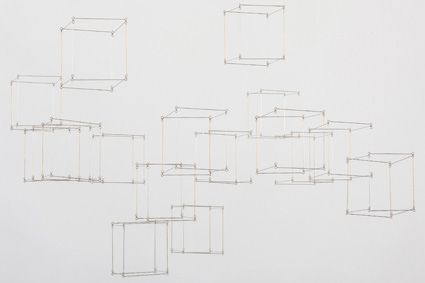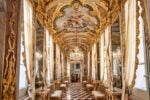Drawing in space

Mostra collettiva
Comunicato stampa
We are pleased to announce the exhibition "Drawing in Space", in which we will present sculptures and installations by eight artists who have expanded drawing into real space since the 1950ies until today.
Drawing is traditionally held on a surface: it is traced with pencil, pen or brush on paper. Since the mid-twentieth century some artists began to go beyond the limits of the medium, pushing lines away from the surface and into real space. Soon after they had given autonomy to the lines, using materials such as metal wire, thread, sticks, as well as light and shadow, they began to make them move, thus adding the fourth dimension: time. In the exhibition "Drawing in Space" we will show works by some of the most important artists researching in this field since the 1950ies until today.
Fausto Melotti (*1901 Rovereto - 1986 Milan), a leading figure of 20th Century art in Italy, began to create essential poetic sculptures made of copper wire and steel, thus drawing figures and geometric forms in space since the Fifties.
Gianni Colombo (Milan * 1937 - 1993) was one of the first artists to bring motion into play, thus pioneering kinetic art. With lines made of metal wire or rubber thread he created geometric spaces that are constantly moving, thus giving life to new experiences.
The Swiss artist Markus Raetz (* Bern 1941) analyses visual perception with poetic images and often creates mobiles that move gently transforming themselves as the perspective changes. His sculpture "Szene" displays two dancers and a trapeze: the figures circle slowly and gracefully, while the trapeze changes his position, thus appearing first as a stage, then as a wall, a mirror or a window.
The abstract shapes created by Felice Varini (*Locarno1952, lives in Paris) seem to float in the architectural space. Once they are viewed from a different angle however, they dissolve into distorted fragments. The shapes are painted on walls, floors and ceilings, forming an almost magical floating image that can be seen only from a single point of view, thus creating a playful optical illusion that addresses the relativity of space and time.
The conceptual artist Goran Petercol (*1949 Pula, lives in Zagreb) in his work juxtaposes opposites such as planning and chance. In the series of sculptures "Sjene" (shadow) he creates images made of metal wires and shadows.
The geometric structures of the Venezuelan artist Elias Crespin (*1965 Caracas, lives in Paris) hover and move slowly in the air following a precise choreography, in sequences that are reminiscent of a dance. The constellations change slowly, going through different stages of order and disorder. His works are to be found in major museums, including Museum of Fine Arts in Houston; the Museum of Latin American Art in Buenos Aires and the Museo del Barrio in New York.
Andres Lutz (*1968 Wettingen ) and Anders Guggisberg (*1966 Biel) thanks to their multifaceted work are among the most important Swiss artists of their generation. Through the richness and variety of the content, media and techniques they use, they are able to constantly reinvent their art, while their style remains totally recognizable. They tackle their motifs with freshness, nonchalance and a keen sensitivity, that allows their works to balance in the space between seriousness and laconic humor. In the exhibition they will build a large drawing in space composed of different materials and objects.
The work of Hungarian artist Attila Csörgö (*1965 Budapest) revolves around the relationships between art, science and research. The artist carries out scientific experiments and builds complex machines. The results are unexpected, playful, ironic, poetic and yet technically accurate. In the exhibition he shows the sculpture "Spherical Vortex": a machine that puts a tiny lamp in spinning circular motion, so that it shapes lines of light creating spirals, a dome and finally a full sphere. Csörgö in 1999 represented his country at the Venice Biennale; he also took part in the Istanbul Biennial in 2003, the Sydney Biennial in 2008 and Documenta in Kassel in 2012. In 2008 he was awarded with the Nam June Paik Award for media art.



